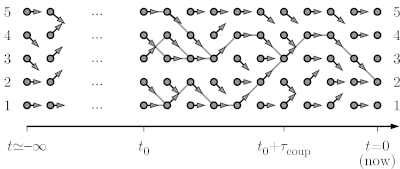Diffusion CFTP.py
From Werner KRAUTH
(Difference between revisions)
| Revision as of 15:03, 7 June 2024 Werner (Talk | contribs) ← Previous diff |
Revision as of 15:06, 7 June 2024 Werner (Talk | contribs) (→Context) Next diff → |
||
| Line 6: | Line 6: | ||
| [[Image:One d cftp.png|left|600px|border|Coupling-from-the-past approach to sampling.]] | [[Image:One d cftp.png|left|600px|border|Coupling-from-the-past approach to sampling.]] | ||
| <br clear="all" /> | <br clear="all" /> | ||
| + | At time t=-infinity, as shown, the pebble starts on configuration 1, so that, by time t=0, it must sample the stationary distribution (the uniform distribution on the five sites). The below program constructs just as many set of arrows as needed to conclude on where it finishes it infinitely long journey. | ||
| ==Python program== | ==Python program== | ||
Revision as of 15:06, 7 June 2024
Context
This page is part of my 2024 Beg Rohu Lectures on "The second Markov chain revolution" at the Summer School "Concepts and Methods of Statistical Physics" (3 - 15 June 2024).
In the example of a particle diffusing on a path graph with five sites, with moves from configuration i to [i-1, i, i] being proposed, we consider the formulation of a Markov chain in terms of random maps, but run from time t=-infinity up to time t=0.
At time t=-infinity, as shown, the pebble starts on configuration 1, so that, by time t=0, it must sample the stationary distribution (the uniform distribution on the five sites). The below program constructs just as many set of arrows as needed to conclude on where it finishes it infinitely long journey.
Python program
import random
import matplotlib.pyplot as plt
N = 5
pos = []
for stat in range(100000):
all_arrows = {}
time_tot = 0
while True:
time_tot -= 1
arrows = [random.choice([-1, 0, 1]) for i in range(N)]
if arrows[0] == -1: arrows[0] = 0
if arrows[N - 1] == 1: arrows[N - 1] = 0
all_arrows[time_tot] = arrows
positions=set(range(0, N))
for t in range(time_tot, 0):
positions = set([b + all_arrows[t][b] for b in positions])
if len(positions) == 1: break
a = positions.pop()
pos.append(a)
plt.title('Backward coupling: 1-d with walls: position at t=0')
plt.hist(pos, bins=N, range=(-0.5, N - 0.5), density=True)
plt.savefig('backward_position_t0.png')
plt.show()

